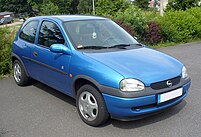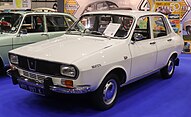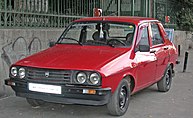
Back هندسة الهوية Arabic Badge-Engineering German Badge engineering Spanish Märgivahetus Estonian بازنشانی خودرو Persian Badge-engineering Finnish Badge Engineering FRR Penamaan ganda ID Badge engineering Italian バッジエンジニアリング Japanese
This article has multiple issues. Please help improve it or discuss these issues on the talk page. (Learn how and when to remove these messages)
|
In the automotive industry, rebadging is a form of market segmentation used by automobile manufacturers around the world. To allow for product differentiation without designing or engineering a new model or brand (at high cost or risk), a manufacturer creates a distinct automobile by applying a new "badge" or trademark (brand, logo, or manufacturer's name/make/marque) to an existing product line.[1][2]
Rebadging is also known as rebranding and badge engineering; the latter is an intentionally ironic misnomer in that little or no actual engineering takes place.[3][4] The term originated with the practice of replacing an automobile's emblems to create an ostensibly new model sold by a different maker. Changes may be confined to swapping badges and emblems, or may encompass minor styling differences, as with cosmetic changes to headlights, taillights, front and rear fascias, and even outer body skins. More extreme examples involve differing engines and drivetrains. The objective is "to spread the huge development costs of a new vehicle over as many cars as possible".[5] An example is General Motors' rebadging of the Camaro as the Firebird, a successful model from the 1960s through to the 2000s.[6] In most cases, consumers are interested in each brand's focus "on the unique elements of styling and driving characteristics".[5] Some cars would not be marketed without the cost savings that are obtained from this practice, and carmakers can develop many "different models – all wearing different badges – off the one platform".[7]
In several countries including Japan, manufacturers often use the phrase "OEM supply" or "OEM-supplied" to denote vehicles that are a rebadged model from or for other manufacturers.[8][9][10]
Although platform sharing can often involve rebadging and rebranding, it can extend further, as the design may be used across multiple configurations. For example, a single platform may underpin a sedan, hatchback, or SUV/CUV body designs.
Automotive industry rebadging can be compared with white-label products in other consumer goods industries, such as consumer electronics and power tools.
- ^ Chambers, Cliff (4 November 2011). "What is badge engineering?". motoring.com.au. Retrieved 6 April 2015.
- ^ Fingleton, Eamonn (7 April 2013). "Same Car, Different Brand, Hugely Higher Price: Why Pay An Extra $30,000 For Fake Prestige?". Forbes. Retrieved 6 April 2015.
- ^ Orlove, Raphael (3 May 2014). "The Ten Best Examples of Badge Engineering". Retrieved 6 April 2015.
- ^ Martin, Murilee. "Badge Engineering". The Truth About Cars. Retrieved 6 April 2015.
- ^ a b Duff, Craig (28 October 2016). "Badge engineering and shared platforms explained". CarsGuide. Retrieved 6 December 2020.
- ^ Orlove, Raphael (5 March 2014). "The Ten Best Examples of Badge Engineering". Jalopnik. Retrieved 6 December 2020.
- ^ Hagon, Toby (23 July 2020). "Keeping it in the family: why car makers share platforms with rivals". News.com.au. Retrieved 6 December 2020.
- ^ "Maruti adds Toyota Glanza sales in their report as sales to other OEM". RushLane. 1 May 2019. Retrieved 6 December 2020.
- ^ "Toyota to build Suzuki-badged RAV4 and Corolla wagon for Europe". International Fleet World. 20 March 2019. Retrieved 6 December 2020.
- ^ "Next Mitsubishi Flagship Could Be Rebadged Infiniti M--In Japan, At Least". Motor Authority. Retrieved 6 December 2020.



